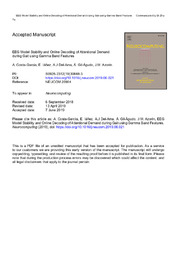Por favor, use este identificador para citar o enlazar este ítem:
https://hdl.handle.net/11000/6014Registro completo de metadatos
| Campo DC | Valor | Lengua/Idioma |
|---|---|---|
| dc.contributor.author | Costa García, Álvaro | - |
| dc.contributor.author | Láñez, E. | - |
| dc.contributor.author | Del Ama, A.J. | - |
| dc.contributor.author | Gil Agudo, A. | - |
| dc.contributor.author | Azorín Poveda, José María | - |
| dc.contributor.other | Departamentos de la UMH::Ingeniería de Sistemas y Automática | es |
| dc.date.accessioned | 2020-05-19T07:14:59Z | - |
| dc.date.available | 2020-05-19T07:14:59Z | - |
| dc.date.created | 2019-06-19 | - |
| dc.date.issued | 2020-05-19 | - |
| dc.identifier.issn | 0925-2312 | - |
| dc.identifier.uri | http://hdl.handle.net/11000/6014 | - |
| dc.description.abstract | Rehabilitation therapies are evolving oriented to improve their performances in terms of functional recovery. To achieve such recovery, the patients’ involvement is an important factor that correlates with the plastic properties of the brain. By evaluating electroencephalographic signals, it is possible to modify, in real time, the parameters of the rehabilitation according to the patients’ cognitive state. In this paper, an online brain–machine interface to measure the attention level during gait is presented. The system is based on the measurement of selective attention mechanisms manifested as power synchronization and desynchronization in the gamma band. A Linear Discriminant Analysis classifier is used to provide an attention index between 0 and 1 in real time. Robust techniques for artifact rejection and signal standardization are used in order to deal with the problems associated to the measurement of cortical signals during walking. The final interface is validated with 4 incomplete Spinal Cord Injury patients and 4 healthy participants. The system shows an average success rate of 68.1% in the classification of 3 attention levels and a stable behavior of these results during time | es |
| dc.description.sponsorship | This research has been funded by the Commission of the European Union under the BioMot project – Smart Wearable Robots with Bioinspired Sensory-Motor Skills (Grant Agreement number IFP7-ICT- 2013-10-611695) | - |
| dc.description.sponsorship | and by the Spanish Ministry of Science, Innovation and Universities, the Spanish State Agency of Research, and the Commission of the European Union through the European Regional Development Fund. under the Walk project - Controlling lower-limb exoskeletons by means of brain-machine interfaces to assist people with walking disabilities (Grant Agreement number RTI2018-096677-B-I00). | - |
| dc.format | application/pdf | es |
| dc.format.extent | 37 | es |
| dc.language.iso | eng | es |
| dc.rights | info:eu-repo/semantics/openAccess | es |
| dc.subject | Attention level | es |
| dc.subject | Gait | es |
| dc.subject | EEG | es |
| dc.subject | Online | es |
| dc.subject.other | 62 - Ingeniería. Tecnología | es |
| dc.title | EEG model stability and online decoding of attentional demand during gait using gamma band features | es |
| dc.type | info:eu-repo/semantics/article | es |
| dc.identifier.doi | 10.1016/j.neucom.2019.06.021 | - |
| dc.relation.publisherversion | http://dx.doi.org/10.1016/j.neucom.2019.06.021 | - |

Ver/Abrir:
1-s2.0-S0925231219308483-main(embargado 24 mese).pdf
3,76 MB
Adobe PDF
Compartir:
 La licencia se describe como: Atribución-NonComercial-NoDerivada 4.0 Internacional.
La licencia se describe como: Atribución-NonComercial-NoDerivada 4.0 Internacional.
.png)